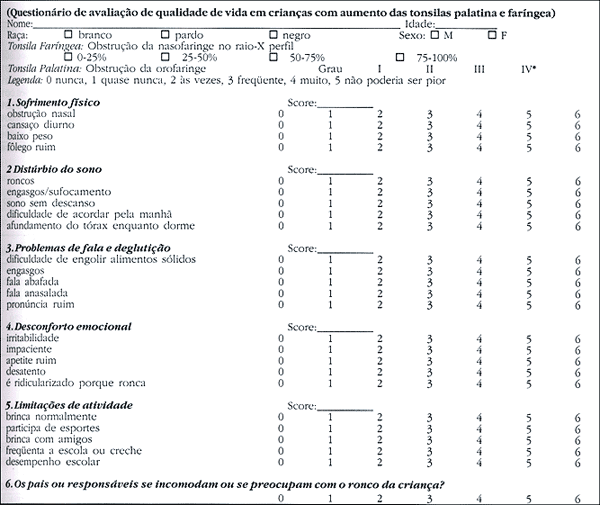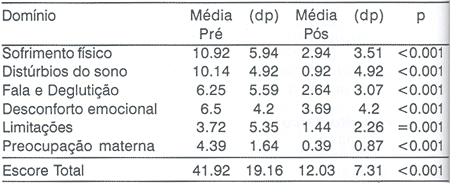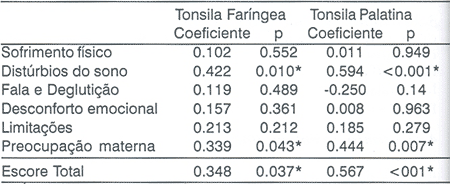

Year: 2004 Vol. 70 Ed. 6 - (5º)
Artigo Original
Pages: 749 to 751
Quality of life improvement in children after adenotonsillectomy
Author(s): Renata C. Di Francesco , Felipe S. G. Fortes , Clarissa L. Komatsu2
Keywords: Key words: obstructive sleep apnea, adenotonsillectomy, quality of life.
Abstract:
Summary
Introduction: Enlarged tonsils is one of the most frequent problems in the ENT doctor office, and this is the main cause of sleep apnea in children. Objective: Evaluate the impact of adenotonsillectomy surgery in the quality of life of children with adenotonsillar hyperplasia. Material and Methods: We have interviewed 36 parents of children with sleep disordered breathing before and after adenotonsillectomy (one month after) using a specific questionnaire (Serres et al. 2000) that included: physical suffering, sleep disturbance, speech and swallowing, emotional distress, activity limitations, caregiver concern. Results: The quality of life in all children improved after surgery. It was observed a direct correlation between the airway obstruction and sleep disturbance, caregiver concern, and general score. In the correlation among the domains, we observed a statistical correlation between emotional distress and sleep disturbance, caregiver concern and sleep disturbance, activity limitations and emotional distress. Conclusion: Enlarged tonsils and sleep apnea worsen the quality of life in children, mainly in physical suffering and sleep disorders. Adenotonsillectomy really improves the quality of life in these children.
![]()
INTRODUCTION
Enlarged palatine and pharyngeal tonsils is one of the most frequent occurrences in otorhinolaryngology. It is the main cause of obstructive sleep apnea in children, accounting for about 75% of the cases1. Tonsil removal (adenotonsillectomy) is the treatment of choice2, today it is the most common surgery performed by otorhinolaryngologists in the USA3.
Enlarged tonsils and resulting airway obstruction may cause orthognathic dysfunction, chewing and swallowing difficulties and dental arch abnormalities4,5. Other important consequences are associated with developmental abnormalities, behavioral disorders, poor school performance and cor pulmonale 6,7. Although the indications for adenotonsillectomy are well established, there are few studies about the impact of surgery in the quality of life of patients8. "Quality of life," an expression used since the 90's, is used to evaluate the impact of diseases9 on the patients' life.
The main purpose of this study was to compare scores of the Questionnaire about the quality of life of children with enlarged tonsils before and after adenotonsillectomy.
MATERIAL AND METHOD
We interviewed 36 parents/guardian of children who underwent adenotonsillectomy to treat obstructive sleep disorders resulting from enlarged palatine and pharyngeal tonsils. We used a special questionnaire (based on the study from Serres et al, 20008) to evaluate the patients (Figure 1).
Figure 1. Model of questionnaire to evaluate quality of life.
We included in the study patients aged 2 to 15 years, whose pharyngeal tonsils affected over 75% of the rhinopharynx (based on paranasal sinuses radiographic findings) and who also presented enlarged palatine tonsils (grade II or higher)7. Children presenting craniofacial abnormalities and neurological disorders were excluded from this study, as well as those patients referred to surgery to treat recurrent tonsillitis.
Parents/guardians answered the Questionnaire based on history 2 months before and 1 month after surgery. The Questionnaires were not applied by the same team who performed surgery.
RESULTS
We evaluated 36 patients, ranging from 2 to 15 years old (average 6.58 years), 14 girls and 22 boys.
Table 1 shows the average score for each item of the Questionnaire, before and after surgery. We distributed the patients into two groups according to their age (2 to 7 and 7 to 15 years old); there was no statistically significant difference between groups. All children improved after surgery. Two patients who showed less improvement after surgery (5%) also had associated rhinitis.
Comparing the level of obstruction caused by pharyngeal and palatine tonsils, we found direct and statistically significant difference between the level of obstruction and sleep disorders, parent's/guardian's concern and general average of items of the Questionnaire (Table 2).
Comparing the items, we found positive association between physical distress and sleep disorders, mother's concern and sleep disorders and limitation of activities and emotional distress (Table 3).
DISCUSSION
Generally, the greatest concern of any disease refers to its physical consequences. However, the impact of a disease on the quality of life of a patient, or his parent/guardian, should also be taken into account when choosing treatment approaches.
Adenotonsillectomy is one of the most common surgeries performed in children3. Although we still do not know all consequences of adenoid and tonsil enlargement, we believe that obstructive sleep apnea accounts for the highest morbidity1. Other consequences, described as minor ones, include weight and height developmental disorders, craniofacial problems resulting from mouth breathing, chewing and swallowing difficulties and high susceptibility to upper airway infections4-6. The disease's high morbidity and its impact over the patient's life should be considered when choosing the best treatment approach.
Quality of life has been recently used to evaluate the impact of a disease under the patient's perspective. The Questionnaire used in this study is based on Serres' study8, validated for children presenting obstructive sleep disorders. This Questionnaire was used to evaluate the impact of a disease on the patient, in an attempt to include this item and address its severity and importance when evaluating children with enlarged tonsils8. The Questionnaire used in this study is a special tool to evaluate the impact of adenotonsillectomy on the quality of life of patients.
Table 1. Comparison among pre and postoperative average scores.
"t" Student's test for paired data with significance of p 0.050.
Table 2. Table of correlation between obstruction level and items.
Spearman's Analysis (p?0.05) *significant.
Table 3. Comparison among items.
Note: Only the items with positive correlation are showed on the table.
We found poor association between level of upper airway obstruction and its impact on quality of life of patients, corroborating Serres's findings10. However, when we evaluate each item separately, we note that sleep disorders and physical distress are directly proportional to the level of obstruction. Emotional stress, limitation of physical activities and patient's/guardian's concern do not correlate to the degree of obstruction.
Emotional stress and limitation of physical activity did not show low score, as we expected; parent's/guardian's concern was more associated with physical disorders. Other studies found different results for parent's/guardian's concern and the concept of health11, probably related to cultural differences.
Speech and swallowing disorders are common in patients presenting upper airway obstruction4, although they did not have a comparative high score. Possibly, it shows that parents/guardians give greater importance to sleep disorders and physical distress, because they were considered to pose great risk for one's health, or because they were not associated with the problem. When we compared such scores after surgery, we noted that they were higher.
There was no difference in scores considering age of the patients. This finding showed us that parent's/guardian's perspective is the same for patients between 2 and 15 years old.
After surgery, there was significant improvement on score averages for all items, proving the success of the surgery to improve the quality of life of the patients. The improvement was greater in items related to physical distress and sleep disorders.
Children presenting rhinitis associated with enlarged palatine and pharyngeal tonsils (5%) had mild improvement on scores. This finding is similar to Serres'10, who noted 6% mild improvement.
Our results, as well as other authors' results,10 suggest that adenotonsillectomy presents greater benefit to children with obstructive sleep disorders.
CONCLUSION
We concluded that enlarged pharyngeal and palatine tonsils and obstructive sleep apnea negatively affect the quality of life of children, especially due to the physical distress and sleep disorders resulting from them. After surgery, there is great improvement in quality of life of patients.
REFERENCES
1. Nimubona L, Jokic M, Moreau S, Brouard B, Guillois B, Leacheux C. Le syndrome d'apnées obstructives du sommeil et hypertrophie amygdalienne chez le nourisson. Arch Pédiatr 2000; 7: 961-4.
2. McNanama F, Sullivan CE. Treatment of obstructive sleep apnea syndrome in children. Sleep 2000; 23 (Suppl. 4) 142-6.
3. Paradise J. Tonsillectomy and Adenoidectomy. In Bluestone C. Pediatric Otolaryngology. Philadelphia: W. B. Saunders; 1996.
4. Junqueira PAS, Di Francesco RC, Trezza P, Frizzarini R, Faria ME. Alterações funcionais do sistema estomatognático pré e pós adenoamigdalectomia. Pró-fono Revista de atualizaçnao Científica. 2002; 14:17-22.
5. DiFrancesco RB, Junqueira P, Trezza P, Faria ME, Frizzarini R, Zerati F. Improvement of Bruxism after T&A Surgery. Int J Pediatr Otorhinolaryngol 2002; 100-5.
6. DiFrancesco RC, Junqueira PA, Frizzarini R, Zerati F. Crescimento pondero-estatural de crianças após adenoamigdalectomia. Rev Bras Otorrinolaringol 2003; 193-7.
7. Guilleminault C, Pelayo R. Sleep-disordered breathing in children. Annals of Medicine. 1998; 30: 350-6.
8. Serres LM, Derkay C, Astley S, Deyo RA, Rosenfeld RM, Gates GA. Measuring quality of life in children with sleep disorders. Arch Otolaryngol Head Neck Surg. 2000; 126: 1423-9.
9. Morton RP. Quality of life assessment: integral to clinical practice. Clin Otolaryngol. 1996; 21(1):1-2.
10. Serres LM, Derkay C, Sie K, Biavati M, Jones J, Tunkel D, Manning S, Inglis A, Haddad Jr J, Tampakopoulou D, Weiberg AD. Impact of adenotonsillectomy on quality of life in children with sleep disorders. Arch Otolaryngol Head Neck Surg 2002; 128: 489-96.
11. Stwart MG, Friedman EM, Sulek M. Quality of life and health status in pediatric tonsil and adenoid disease. Arch Otolaryngol Head Neck Surg 2000; 126: 45-8.
------------------------------
1 Ph.D. in Medicine, FMUSP.
2 Assistant Physician, Division of Otorhinolaryngology, Hospital das Clínicas, Medical School, University of Sao Paulo.
3 Resident Physician, Division of Otorhinolaryngology, Hospital das Clínicas, Medical School, University of Sao Paulo.
Study presented at III Congresso Triológico, Rio de Janeiro, October 8 - 11, 2003, and at 107th Annual Meeting AAO-HNS Foundation - Otolaryngology Head and Neck Surgery, Orlando, USA, in September 2003.
Address correspondence to: Felipe S. G. Fortes - Rua Fernão Cardim, 161 Ap. 154 São Paulo SP 01403-020.
E-mail: fsgfortes@yahoo.com.br



